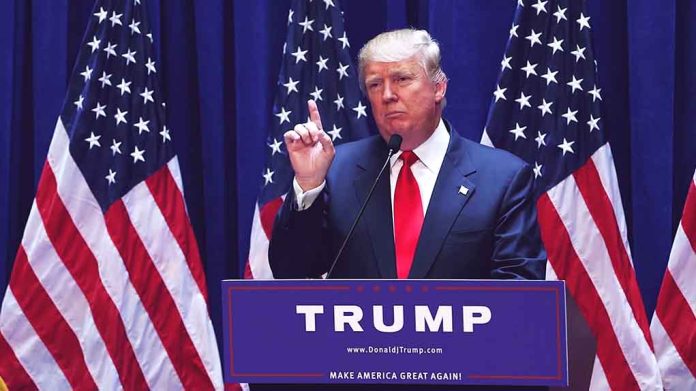
President Trump has launched a bold campaign for a ‘full point’ cut in Federal Reserve interest rates, challenging Jerome Powell to take action as inflation shows signs of cooling despite the central bank’s reluctance to abandon its restrictive monetary stance.
Key Takeaways
- President Trump is calling for the Federal Reserve to slash its benchmark interest rate by a full percentage point, citing solid job growth and cooling inflation
- A full point reduction would bring rates to 3.25%-3.5%, the lowest level since September 2022, well below the current 5.25%-5.5% range
- Trump made his economic recommendation on Truth Social following the release of May inflation data, suggesting lower rates would reduce interest payments on government debt
- Fed officials remain cautious about rate cuts due to concerns that Trump’s proposed tariffs could potentially trigger renewed inflation
- The Federal Reserve’s independence from political influence is being tested as Trump intensifies pressure for monetary policy changes
Trump’s Call for Dramatic Rate Reduction
President Trump is pushing for a significant shift in Federal Reserve policy, urging the central bank to cut interest rates by a full percentage point. This dramatic move would be substantially larger than the Fed’s typical quarter-point adjustments and represents the most aggressive rate reduction since the emergency cuts implemented during the COVID-19 pandemic in March 2020. Trump’s recommendation comes after recent economic data showed inflation cooling while employment remains strong, creating what he views as ideal conditions for monetary easing that could further stimulate economic growth.
In his characteristic direct style, Trump wrote on Truth Social following the release of May inflation figures: “Great numbers! Fed should lower one full point,” he further emphasized that this would be “Rocket Fuel!” for the economy, according to President Donald Trump.
❝FED SHOULD LOWER ONE FULL POINT❞
US President Donald Trump hailed lower-than-expected annual and monthly inflation data out while again urging Federal Reserve to lower interest rates to cut cost of borrowing https://t.co/9UvPCuUeOm pic.twitter.com/9ts7cCS1T4
— Anadolu English (@anadoluagency) June 11, 2025
Economic Strategy Behind the Recommendation
The timing of Trump’s call is strategic, coming after May inflation data showed only a slight increase in consumer prices. By advocating for such a substantial rate cut, the President is promoting a more accommodative monetary policy that would make borrowing cheaper for businesses and consumers alike. This approach aligns with his broader economic vision of prioritizing growth and job creation through policies that reduce barriers to business expansion and consumer spending. Trump believes the Federal Reserve has been overly cautious in its approach to inflation, maintaining higher rates longer than necessary.
US President Donald Trump on Wednesday insisted that “the Federal Reserve should cut interest rates after the release of inflation data that showed consumer prices up slightly in May.”
The President has also linked his rate cut proposal to government debt management, stating “it would pay much less interest on debt coming due,” according to President Donald Trump. This perspective highlights Trump’s focus on addressing the growing national debt through monetary policy rather than just fiscal restraint. However, economists note that lower interest rates typically increase consumer prices over time, creating a potential contradiction in this dual approach to managing both inflation and debt service costs.
Federal Reserve Independence Under Pressure
Trump’s direct call for rate cuts represents a continuation of his approach to influencing the Federal Reserve, an institution traditionally insulated from political pressure. While the Fed is designed to operate independently from the executive branch, Trump has been unusually vocal about monetary policy throughout his presidency. His recent comparison between the Federal Reserve and the European Central Bank, which has moved more aggressively to lower rates, signals his dissatisfaction with Jerome Powell’s more cautious approach to monetary policy adjustments.
Fed officials have reportedly expressed concerns about Trump’s proposed tariff policies, which some economic analysts believe could potentially drive inflation higher. This creates a policy tension between Trump’s desire for lower interest rates and his trade policies, which might necessitate higher rates to counteract inflationary pressures. A full percentage point cut would bring the fed funds rate to 3.25%-3.5%, representing a dramatic shift from the current 5.25%-5.5% range that has been maintained to combat inflation.
Market and Economic Implications
The financial markets are closely watching this developing tension between the White House and the Federal Reserve. A rate cut of the magnitude Trump is advocating would likely send immediate positive signals to equity markets and could accelerate economic growth in the short term. However, some economic analysts worry that such aggressive monetary easing without corresponding inflation control could lead to asset bubbles or renewed price pressures down the road. The balancing act between supporting economic growth and maintaining price stability remains at the heart of this policy debate.
Trump’s economic recommendations come at a crucial time as his administration continues implementing policies aimed at supporting American businesses and workers. By pushing for lower interest rates, the President is demonstrating his commitment to using every available economic lever to maintain the strong employment numbers while addressing the cost pressures that have affected American households. How the Federal Reserve responds to this direct presidential input will be closely watched by economic observers worldwide.







